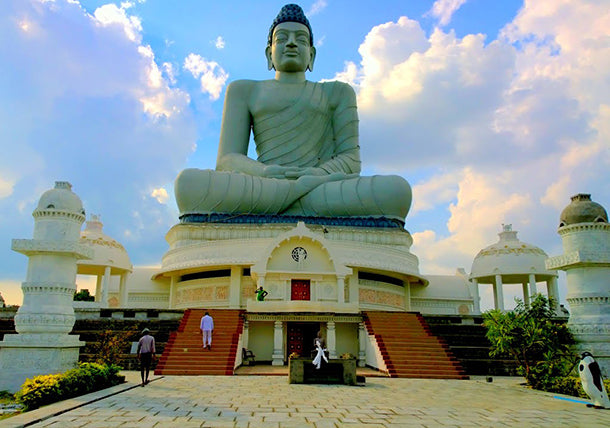The states of Andhra Pradesh and Telangana are historically rich in every aspect. With the advent of Buddhism in our country, the people of these telugu states also merged themselves in the chanting of the monks and the prayers echoed in the air. Even after years their influence still remains in these places. They left their everlasting touch in the form of their constructions all across the state. Even though, the following of Buddhism has been gone down with time, their monasteries and sthupas still intact cherish the stories behind them. Here’s a list of famous Buddhist monasteries in Andhra Pradesh and Telangana which stand as the symbols of the heritage.
1. Salihundam Salihundam, which is located in the district of Srikakulam is one of the important Buddhist excavation sites. It is a village lying on top of the hill to the southern bank of river Vamsadhara. Due to the impactful presence of Buddhism during 2nd and 3rd centuries, this area was excavated in 1919.

2. Ramatheertham Ramatheertham, a coastal area in Vizianagaram ha a line of three small hills on which we can find many ruins of Buddhist sthupas. The southern most hill, Bodhikonda has a ruined temple which is a famous attraction. This site was fund in a pre-independence excavations.

3. Thimmapuram According to historians, Buddhist activities were at their peaks near Thimmapuram in 2nd and 3rd centuries, which is currently a part of Visakhapatnam. It came into existence along with Bavikonda and Pavurallakonda. It was a residential space for many buddhist monks. It is said to have accommodated more than 100 monks.


4. Bojjannakonda This place is near Anakapalli in Visakhapatnam district. This hill was originally called Sangharam (Sankaram) which repreents the Boudharamas present there. There is Lingalakonda near to it which is also a prominent buddhiist site. These were the learning centers for all the Buddhist monks back then.

5. Kotturu This is an ancient Buddhist remain site with a Maha Stupa and Remains of Vihara's along with a small portion of rock cut cave used by Buddhist monks during 1ST century BC to 2ND century AD on the hilly forest area. It lies along the banks of River Sarada. This place is locally called 'Dhanadibbalu'.

6. Kodavali This Boudha Ramam belongs to Satavahana period at Kodavali in Gollaprolu mandal. A hill situated near to the village where Boudha Ramam constructed. This is one of the 84,000 Stupa constructed by Emperor Ashoka. Kodavali Boudha Ramam situated on 3 Kms away from the National Highway No 5, 65 Kms away from Rajahmundry and 45 Kms away from Kakinada.

7. Guntupalli The Guntupalle or Guntupalli Group of Buddhist Monuments is located near Kamavarapukota, West Godavari district. The rock-cut part of the site has two Buddhist caves, a chaitya hall and a large group of stupas. The chaitya hall has a rare carved stone entrance replicating wooden architecture, a simpler version of that at the Lomas Rishi Cave.

8. Gudiwada Gudiwada Dibba is a small hillock at Gudiwada village in Bhogapuram mandal, Vizianagaram district. It located on the banks of River Gosthani. This site has some resemblance to Pavurallakonda and Thotlakonda Buddhist site in the near Vicinity. It is 6 km away from Bheemili.

9. Ghantasala During the excavations in Ghantasala village in Krishna district many traces of Buddhism were found. Objects such as a four-by-three-feet 'Purna Kalasa' containing lotus flowers, indicating the birth of Gautama Buddha were also discovered.

10. Bhattiprolu Bhattiprolu is a village in Guntur district. The Buddhist stupa in the village is one of the centrally protected monuments of national importance. Three mounds were discovered in Bhattiprolu in 1870. The most significant discovery is the crystal relic casket of sarira dhatu of the Buddha from the central mass of the stupas.

11. Amaravathi An ancient significant pilgrimage site with a superb collection of Buddhist monuments dating back to 2000 years old. There is a museum by the name of this place putting on sight the archaeological items from other Buddhist destinations including relic-caskets, a gold necklace, bone-relics and gold flowers.

12. Jaggayapeta The Archaeological excavation around the town of Jaggayyapeta has found Buddhist stupa of 200 BC. This is a small village in Krishna district. This town is located on the banks of the river Paleru.

13. Nagarjunakonda Nagarjunakonda is a historical Buddhist town, now an island located near Nagarjuna Sagar in Guntur. It is one of India's richest Buddhist sites, known in the ancient times as Sri Parvata. It is named after Nagarjuna, a southern Indian master of Mahayana Buddhism who lived in the 2nd century AD, who is believed to have been responsible for the Buddhist activity in the area.

14. Nandikonda Nandikonda is a small village on the banks of River Krishna in Telangana. Remnants of strong Buddhist culture were found in this region during excavations. Many pillared halls and monasteries were found during the excavations here.

15. Devunigutta In the recent Archaeological excavations a biggest find is the 6th century Buddhist Vajrayana Temple at Devunigutta village in Prof Jayashankar Bhupalpally district of Telangana. The architectural style of the temple resembles Angkor Wat of Cambodian architecture or Java’s Barabadur Buddhist Temple which belong to 6th century or even older.









